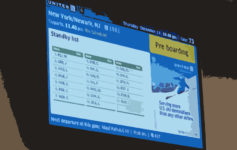An Amtrak train traveling from Seattle to Los Angeles made an unexpected stop in a small town in Oregon…for 37 hours.
Amtrak’s Coast Starlight service runs daily between Los Angeles and Seattle. The 36-hour journey mostly follows the Pacific coast, making several stops along the way in towns both large and small. You can read my own review of Amtrak’s Coast Starlight in a Superliner Bedroom here.
> Read More: Amtrak Coast Starlight Review
But 183 passengers onboard encountered an unexpected stop in a small town called Oakridge, about 150 miles south of Portland, on Sunday night. Just after 6:00PM, the train struck a tree that had fallen across the tracks. The train screeched to a halt and engineers surveyed the damage. Passengers were told to expect a “two hour” delay. But that delay eventually turned into a 37-hour delay. During that time, for safety reasons, passengers were not allowed off the train.
One passenger provided live updates on Twitter:
Rebekah Dodson, a passenger on the Amtrak train stranded in Oakridge just sent me this video. #amtrak#OakRidgepic.twitter.com/nU41KXXqV6
— Lincoln Graves (@LincolnGraves) February 26, 2019
Amtrak’s Chief Operating Officer Scott Naparstek defended the decision to prohibit passengers from disembarking the train:
With more than a foot of heavy snow and numerous trees blocking the track, we made every decision in the best interest of the safety of our customers during the unfortunate sequence of events. With local power outages and blocked roads, it was decided the safest place for our customers was to remain on the train where we were able to provide food, heat, electricity and toilets.
And in a litigious world, that logic makes sense doesn’t it? I do not blame Amtrak for keeping passengers onboard.
CONCLUSION
Yesterday morning at about 5:30A.M. a back-up engine arrived and the train started moving back…right back to Seattle where it had started. Passengers have not been offered compensation yet, but that is likely coming. Many passengers have been interviewed and all have heaped praises on the Amtrak staff who worked two days straight to keep passengers warm and fed. While I would not have wanted to been one of the 183 passengers onboard, it represents an unforgettable memory. And it certainly could have turned out worse…
How would you have handled a 37-hour Amtrak delay?





Surprised there was no murder on the train. A lost opportunity for great piece of mystery.
This…is why it pays to book a private room on Amtrak and bring snacks 🙂 I heard about this yesterday but originally heard that someone had placed the trees on the track on purpose to disable the train. I doubt that was true.
Sorry, but I disagree that Amtrak made the right call. A delay of 37 hours?! It wasn’t possible to resolve this situation any faster? Would passengers have been stuck on a train in Japan or Germany — even Northern Italy — for *37 hours*?! I wasn’t there, and I don’t work for a railroad, but I really find it hard to believe a European or Asian railroad would have taken 37 hours to resolve the situation.
Where should Amtrak have put the passengers? The town only had two small hotels (if any rooms were even available, the bordering highways where closed due to hazardous conditions, the town also had no power, So…what is your incredible solution? While I have no doubt being stuck sucked, those passengers had heat, food, and no one was injured trying to disembark into deep snow on a train track bed.
As a point of reference, our region (Germany, Austria, Czech Republic, Slovakia) had a nasty start of winter several years ago when temperatures would hover just around freezing point and the overhead wires would become coated with clear ice, stranding all electric trains. While most of the services were simply cancelled, there were several long-distance trains that got stuck for up to 18 hours. This is tricky: unless you are close to a station or a suitable evacuation point, it actually is safer to keep everyone on board—not least because parts of the railway are not easily accessible by other means.
I’ve occasionally been part of a controlled disembarkation on an open stretch of track (due to power loss, vehicle malfunction etc.), but always only when there was a station or another train nearby and traffic had been stopped to ensure safety.